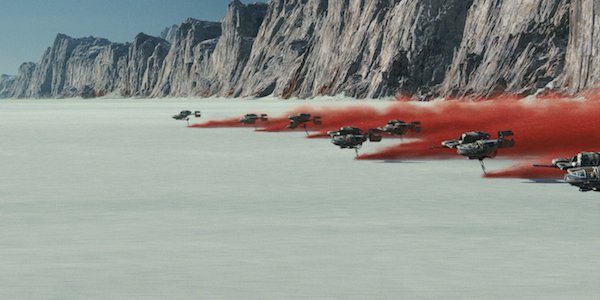What Crait Symbolized In Star Wars: The Last Jedi, According To Rian Johnson

Warning: SPOILERS for Star Wars: The Last Jedi are ahead!
After most of its fleet was destroyed by The First Order, the remnants of The Resistance made one final stand against its enemy in Star Wars: The Last Jedi on the planet Crait. The battle itself echoed The Rebellion's battle against The Empire on Hoth in The Empire Strikes Back, from the underdogs piloting speeders to the tyrannical opposition sending giant armored walkers. But while plotting The Last Jedi, director Rian Johnson wanted to emphasize how devastating this final conflict would be, but rather than just turned the movie's final minutes into a gore fest, Johnson decided to have Crait's terrain symbolize the carnage. As Johnson explained:
I wanted to do a big battle and communicate the violence of it, but you don't show blood in Star Wars movies, these are PG-13 movies. So the initial thing was to have a movie where the landscape itself could graphically communicate the violence of this battle. Also the notion that the landscape could evolve during the course of the battle, the idea at the beginning it's white and pristine and it gets scarred and increasingly red. And when the cannon goes, it blows it all away so it just becomes a red hellscape. And as Luke comes back to the legend he needs to be and [starts] healing the world, the salt starts snowing down so it's back to being pristine.
While earlier Star Wars movies have shown blood on a few occasions, like when Obi-Wan Kenobi sliced off Ponda Baba's arm in A New Hope, for the most part this series has stayed away from being gory. In order to not break this trend in The Last Jedi, Rian Johnson decided to have the mineral coating Crait's surface highlight the violence that unfolded between The Resistance and The First Order. When all is calm, Crait's landscape is the smooth white, but when The Resistance's ski speeders started kicking up the mineral and the laser blasts started flying, then it turned into this "hellscape." Johnson also mentioned to /Filmcast that the idea of red streaks standing out against the white salt planet was a "visual that came about very early," but more importantly, he was able to use said visual to effectively show how war is hell, even in a galaxy far, far away.
There have been numerous conflicts in the Star Wars franchise, but the Crait battle in Star Wars: The Last Jedi ranks as one of the most disastrous. With their numbers at an all-time low and relying on stripped technology left behind by The Rebellion decades ago, The Resistance didn't stand a chance of defeating The First Order. However, Luke Skywalker's "arrival" on Crait ensured that the few remaining Resistance members were able to escape and that beings across the galaxy would be inspired to rise up against The First Order. Hopefully by Episode IX, The Resistance's numbers will have soared enough that it can turn the tables on Kylo Ren's forces and ensure heavy losses like these are never suffered again.
You can learn what we thought of Star Wars: The Last Jedi by reading our review and To 3D guide. The current trilogy will conclude when Star Wars: Episode IX is released on December 20, 2019.
Your Daily Blend of Entertainment News

Connoisseur of Marvel, DC, Star Wars, John Wick, MonsterVerse and Doctor Who lore, Adam is a Senior Content Producer at CinemaBlend. He started working for the site back in late 2014 writing exclusively comic book movie and TV-related articles, and along with branching out into other genres, he also made the jump to editing. Along with his writing and editing duties, as well as interviewing creative talent from time to time, he also oversees the assignment of movie-related features. He graduated from the University of Oregon with a degree in Journalism, and he’s been sourced numerous times on Wikipedia. He's aware he looks like Harry Potter and Clark Kent.
